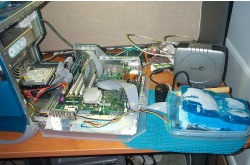Backup now or end up with a Drive-cicle!Submitted by adchen on Mon, 2009/03/30 - 02:33 |
I don't pretend to have the best backup regime yet, but I didn't even regularly do backups until around 2004. My main system at the time was a PowerMac G3 (Blue/white). I was obliviously going day-to-day with all my primary storage on a single 80GB Maxtor drive (back when it would all fit on such a small drive).
Then suddenly one day the drive started to emit a horrible clicking sound (the dreaded Click of Death). After some attempts to scrub the drive with the lowly Disk Utility (Mac OS's fsck), the drive finally stopped mounting at all. I even tried Disk Warrior but it couldn't do anything with the drive because it wouldn't even mount. In hindsight it wasn't smart to keep doing this, as potentially there was some debris loose in the case that was ripping up the platters. At first sign of trouble, I should have stopping forcing it.
Desperation time. Searches on the Internet yielded various suggestions. One method that seemed to keep cropping up seemed a little strange, but there was enough anecdotal testimonials about it to make it worth trying. After all, the drive couldn't get much deader.
If this attempt was a bust, then worst case would be to either shell out big bucks to a drive recovery service, or just lose the data. Suddenly the cost of NOT doing regular backups came back to bite me. Pay a few hundred up front and be safe, or pay perhaps much more later on and not even be assured of getting all your data back.
Anyway, the last-ditch method I read about was the semi well-known "freezer" trick. Originally used back when drives were more prone to locking up and unable to spin up (also known as "stiction"), this method surprisingly still works for today's newer drives, although perhaps for different reasons. Supposedly if you freeze a drive long enough, it would be able to spin up again, at least long enough to recover the data. The longer you freeze the drive, the more run time you have with the drive before it dies again.
So I put the bare drive in a freezer Ziploc bag, squeezed out as much air as possible and put it in the freezer. One of the hints was to make sure you seal the bag very well, so that moisture doesn't get in to the drive from the rest of the freezer. I let it freeze for a few days, just to be extra sure. Theoretically this cools all the drive innards slightly shrinking the components, hoping they'll "unstick" (whatever that may entail).
Since this is a last-ditch effort, assume you have only this one last chance to recover your data, so be ready to grab everything off the drive when you power it back up. Have extra drives at the ready to hold the recovered data, and so on.
After freezing the drive, I reattached the dead drive to my G3, attached a new external drive for storing the recovered data, and booted with a known-good drive. To be completely paranoid, I strapped one of those big blue freezer ice-packs underneath my dead drive even while I was attempting the recovery, just to keep it as cool as long as possible. Thankfully for the PowerMac case design, you can swing the entire motherboard out just by unlatching the side and letting it down:
Now for the other part of the frozen-drive recovery method: you may have to tap the drive a few times to get it to spin-up. Perhaps "smack" is a better word. At first the drive still didn't mount, so I did some very pensive taps with a rubber mallet (shown in the picture). After a few taps didn't do anything, my wife took it upon herself to do what I couldn't bring myself to do and gave the drive a well-deserved WHAM. Voila. Spinning drive. Recovered all the data. Whew.
Lesson learned. Make backups.
- adchen's blog
- Login to post comments
